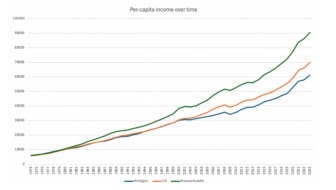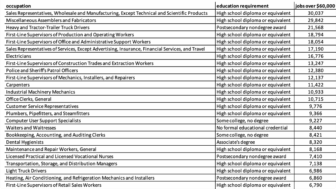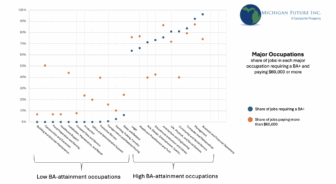For the past year, Michigan Future has collaborated with a group of economic and community development leaders from around the state.
Together, this collaborative released a “Rising Income for All” call to action on March 8, 2020, accompanied by the release of a website, risingincomeforall.org. In addition, we are sending this call to action to political leaders around the state. We encourage you to check out the information available at risingincomeforall.org and to share the call to action with your political and community leaders.
| For the first time ever Michigan is a low-prosperity state with a strong domestic auto industry. The recovery from the Great Recession has produced lots of jobs. Which is good news indeed. But far too many Michigan households are experiencing declining or stagnant incomes. Since the turn of the century––no matter who was in control in Lansing and Washington––more and more Michigan households are struggling to make ends meet. Facing the cost of basic necessities rising faster than wages and benefits. Michigan’s per capita income––in a strong economy with an even stronger domestic auto industry––is 11 percent below the national average. In 2000–– the last time Michigan had a strong economy and domestic auto industry–– Michigan’s per capita income was one percent below. Maybe most concerning is that the portion of per capita income that comes from wages and employer-paid benefits is now 14 percent below the national average. In 2000 it was one percent above. The Michigan Association of United Ways found in 2017, 43 percent of Michigan households were unable to pay for housing, child care, food, transportation, health care, a cell phone, and taxes. They call these households ALICE (Asset Limited, Income Constrained, Employed). What the ALICE data make clear is that this is an all Michigan problem. There are no counties in the state with less than 30 percent ALICE households. Not only is ALICE geographically diverse, but it also is prevalent across age, race, and ethnicity. The ALICE data also make clear that the problem is structural. We are not going to grow our way out of far too many Michigan households unable to pay for the basics. A low unemployment rate will not drive wages, benefits and hours worked up enough to substantially dent the proportion of ALICE households. The proportion of Michigan households unable to pay for basic necessities. We believe a primary goal of state economic policy should be rising household income for all Michiganders. Rising household income for all is different from the most often-used measure for economic success, low unemployment. It is being a place with a broad middle class where wages and benefits allow one to pay the bills, save for retirement and the kids’ education and pass on a better opportunity to the next generation. We believe that this is the prime economic challenge of our times: having an economy that provides enough household supporting jobs––not any job––so that all working Michiganhouseholds can raise a family and pass on a better opportunity to their children. To accomplish that we need state and regional economic development; community development and housing; and workforce development policies and programs that lead to an economy that both grows and benefits all. As a first step, we recommend that reducing the ALICE rate statewide, in every county in Michigan and for every subgroup, become the universal measure of success in meeting the goal of an economy that as it grows, benefits all. |








